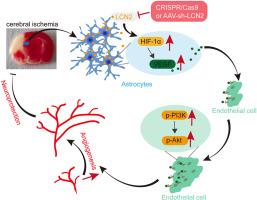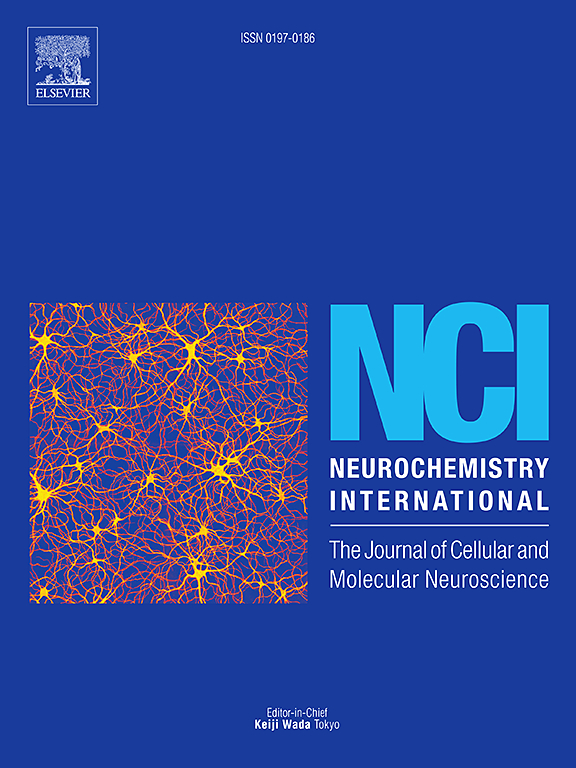星形胶质细胞HIF-1α/VEGF诱导内皮细胞PI3K/Akt激活,在LCN2抑制下加速缺血后血管生成。
IF 4
3区 医学
Q2 BIOCHEMISTRY & MOLECULAR BIOLOGY
引用次数: 0
摘要
治疗性血管生成是脑缺血后功能恢复的关键但尚未充分探索的途径。尽管脂载素-2 (LCN2)参与神经病理过程,但其对缺血后血管重构的细胞类型特异性调控尚不清楚。在这里,我们证明了CRISPR/ cas9介导的C8D1A星形细胞样细胞特异性LCN2敲除显著增强了氧糖剥夺/再灌注(OGD/R)下内皮共培养血管网络的形成。临床上,升高的LCN2 (GDS4521数据集)与卒中预后不良相关。功能分析显示,在光血栓性卒中小鼠中,aav - shrna介导的LCN2敲低减少了梗死体积,减轻了梗死周围神经元的损失,增加了梗死周围血管密度,并在缺血后7天改善了神经行为结果。在机制上,转录组学分析发现缺氧诱导因子1α (HIF-1α)是缺血诱导血管生成的主要调节因子。分子对接证实LCN2-HIF1α相互作用。此外,LCN2消融在C8D1A星形细胞样细胞中释放HIF-1α/VEGF信号级联,通过旁分泌机制激活内皮磷脂酰肌醇-3激酶/蛋白激酶B (PI3K/Akt),驱动功能性血运重建。这些发现不仅重新定义了缺血病理生理学,而且开创了LCN2抑制作为一种翻译策略来克服当前脑血管疾病促血管生成治疗的局限性。本文章由计算机程序翻译,如有差异,请以英文原文为准。

Astrocytic HIF-1α/VEGF induces endothelial PI3K/Akt activation to accelerate post-ischemic angiogenesis upon LCN2 inhibition
Therapeutic angiogenesis represents a pivotal yet underexplored avenue for functional recovery following cerebral ischemia. Although lipocalin-2 (LCN2) participates in neuropathological processes, its cell-type-specific regulation of post-ischemic vascular remodeling remains unknown. Here, we demonstrate that CRISPR/Cas9-mediated C8D1A astrocyte-like cells-specific LCN2 knockout significantly enhances vascular network formation in endothelial co-cultures under oxygen-glucose deprivation/reperfusion (OGD/R). Clinically, elevated LCN2 (GDS4521 dataset) correlates with poor stroke prognosis. Functional analyses revealed that AAV-shRNA-mediated LCN2 knockdown in photothrombotic stroke mice reduced infarct volume, attenuated peri-infarct neuronal loss, increased peri-infarct vascular density, and improved neurobehavioral outcomes at 7 days post-ischemia. Mechanistically, transcriptomic profiling identified hypoxia-inducible factor 1α (HIF-1α) as the master regulator of ischemia-induced angiogenesis. Molecular docking confirmed LCN2-HIF1α interaction. Furthermore, LCN2 ablation unleashes a HIF-1α/VEGF signaling cascade in C8D1A astrocyte-like cells, which activates endothelial phosphatidylinositol-3-kinase/protein kinase B (PI3K/Akt) via paracrine mechanisms to drive functional revascularization. These findings not only redefine ischemic pathophysiology but also pioneers LCN2 inhibition as a translational strategy to overcome the limitations of current pro-angiogenic therapies in cerebrovascular disease.
求助全文
通过发布文献求助,成功后即可免费获取论文全文。
去求助
来源期刊

Neurochemistry international
医学-神经科学
CiteScore
8.40
自引率
2.40%
发文量
128
审稿时长
37 days
期刊介绍:
Neurochemistry International is devoted to the rapid publication of outstanding original articles and timely reviews in neurochemistry. Manuscripts on a broad range of topics will be considered, including molecular and cellular neurochemistry, neuropharmacology and genetic aspects of CNS function, neuroimmunology, metabolism as well as the neurochemistry of neurological and psychiatric disorders of the CNS.
 求助内容:
求助内容: 应助结果提醒方式:
应助结果提醒方式:


